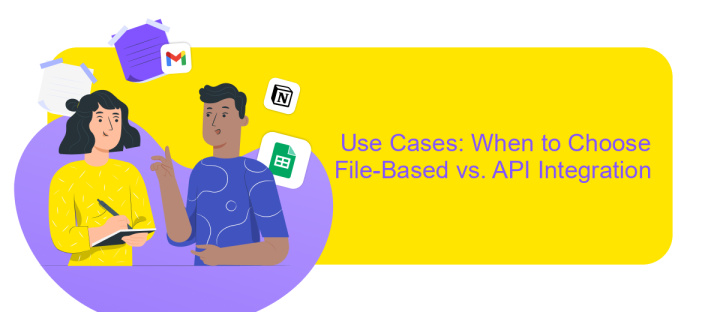File-based Integration vs API
In the rapidly evolving landscape of digital transformation, businesses face critical decisions regarding data integration strategies. Two prevalent methods, file-based integration and API-driven integration, offer distinct advantages and challenges. This article explores these two approaches, examining their core principles, use cases, and potential impacts on organizational efficiency. By understanding the nuances of each method, businesses can make informed choices that align with their technological and operational goals.
Introduction: Defining File-Based Integration and API Integration
In the realm of digital communication and data exchange, file-based integration and API integration represent two fundamental approaches for connecting disparate systems. File-based integration involves the exchange of data files between systems, typically in formats like CSV or XML. This method is often employed in scenarios where systems need to exchange large volumes of data periodically, and it is valued for its simplicity and ease of implementation.
- File-Based Integration: Utilizes data files for communication.
- API Integration: Leverages application programming interfaces for real-time data exchange.
On the other hand, API integration involves the use of application programming interfaces to enable real-time data exchange between systems. This method is preferred when there is a need for immediate data synchronization and is characterized by its ability to provide more dynamic and interactive communication. Understanding these two integration strategies is crucial for businesses aiming to optimize their data management and improve system interoperability.
Key Differences: Data Exchange Mechanisms and Communication Styles

File-based integration and API-based integration fundamentally differ in how they handle data exchange and communication. File-based integration relies on the transfer of bulk data files between systems at scheduled intervals. This method is often asynchronous, meaning the systems involved do not need to be online simultaneously, which can be advantageous for batch processing. However, it may lead to latency issues as data is not exchanged in real-time. In contrast, API-based integration facilitates real-time data exchange, enabling instant communication between systems. APIs use requests and responses, allowing for more dynamic and immediate data interaction.
Communication styles also vary significantly between these two approaches. File-based integration often involves a more rigid, structured format, such as CSV or XML, which can require significant preprocessing. On the other hand, APIs offer more flexibility with data formats like JSON, which are easier to manipulate and integrate. Tools like ApiX-Drive can simplify API integration by providing a user-friendly interface to configure and manage data flows, reducing the complexity involved in setting up and maintaining these connections. This makes API-based integration a more agile and efficient choice for organizations seeking seamless data interoperability.
Advantages and Disadvantages: Flexibility, Security, and Real-time Capabilities

When comparing file-based integration and API-based integration, each approach offers distinct advantages and disadvantages in terms of flexibility, security, and real-time capabilities. Understanding these differences is crucial for organizations aiming to optimize their integration strategies.
- Flexibility: API-based integration generally provides higher flexibility, allowing for dynamic interactions and adaptability to changes. In contrast, file-based integration may be more rigid, often requiring manual adjustments.
- Security: APIs typically offer robust security features, such as authentication and encryption, ensuring data integrity and confidentiality. File-based methods may pose security risks, as files can be intercepted or modified during transfer.
- Real-time Capabilities: APIs excel in real-time data exchange, enabling instant updates and interactions. File-based integration, however, often relies on batch processing, which can introduce delays and limit real-time responsiveness.
Ultimately, the choice between file-based and API integration depends on specific business needs and priorities. While APIs offer enhanced flexibility, security, and real-time capabilities, file-based integration may still be suitable for simpler, less time-sensitive tasks where these factors are less critical.
Use Cases: When to Choose File-Based vs. API Integration

When deciding between file-based and API integration, it's essential to consider the specific needs and constraints of your project. File-based integration is often chosen for its simplicity and ease of use, particularly when dealing with large data sets that require batch processing. It enables straightforward data exchange without the need for constant connectivity, making it suitable for environments with intermittent internet access.
On the other hand, API integration is ideal for real-time data exchange and scenarios where data consistency and immediacy are crucial. APIs allow for seamless interaction between systems, offering flexibility and scalability as your business grows. They are particularly useful when integrating with cloud-based services or when the integration requires frequent updates.
- Choose file-based integration for batch processing and offline environments.
- Opt for API integration for real-time data exchange and cloud-based applications.
- Consider file-based methods for legacy systems with limited API support.
- Utilize APIs for dynamic, interactive user experiences.
Ultimately, the choice between file-based and API integration should be guided by your specific use case requirements, the existing technological infrastructure, and the desired level of data interaction. By carefully evaluating these factors, you can select the most appropriate integration method to support your business objectives.
- Automate the work of an online store or landing
- Empower through integration
- Don't spend money on programmers and integrators
- Save time by automating routine tasks
Conclusion: Selecting the Right Approach for Your Needs
When deciding between file-based integration and API-based integration, it's crucial to evaluate your specific business needs and technical capabilities. File-based integration can be a suitable choice for organizations dealing with large volumes of data exchanged periodically. It is often simpler to implement and requires less real-time processing, making it a cost-effective solution for businesses with limited IT resources. However, it may not be the best fit for scenarios requiring real-time data exchange or frequent updates.
On the other hand, API-based integration offers a more dynamic and flexible approach, providing real-time data access and seamless connectivity between systems. This method is ideal for businesses that require immediate data synchronization and have the technical infrastructure to support it. Services like ApiX-Drive can facilitate API integration by offering user-friendly tools to connect various applications without extensive coding knowledge. Ultimately, the choice between file-based and API integration should align with your operational demands, budget, and long-term strategic goals.
FAQ
What is file-based integration, and how does it differ from API integration?
When should I choose file-based integration over API integration?
What are the advantages of using API integration?
Can file-based integration be automated, and how?
What are the potential drawbacks of API integration?
Strive to take your business to the next level, achieve your goals faster and more efficiently? Apix-Drive is your reliable assistant for these tasks. An online service and application connector will help you automate key business processes and get rid of the routine. You and your employees will free up time for important core tasks. Try Apix-Drive features for free to see the effectiveness of the online connector for yourself.


